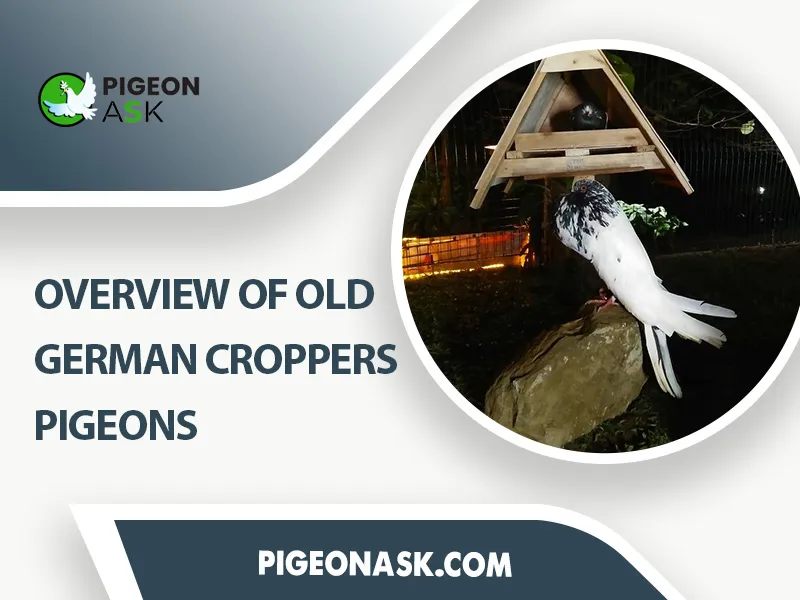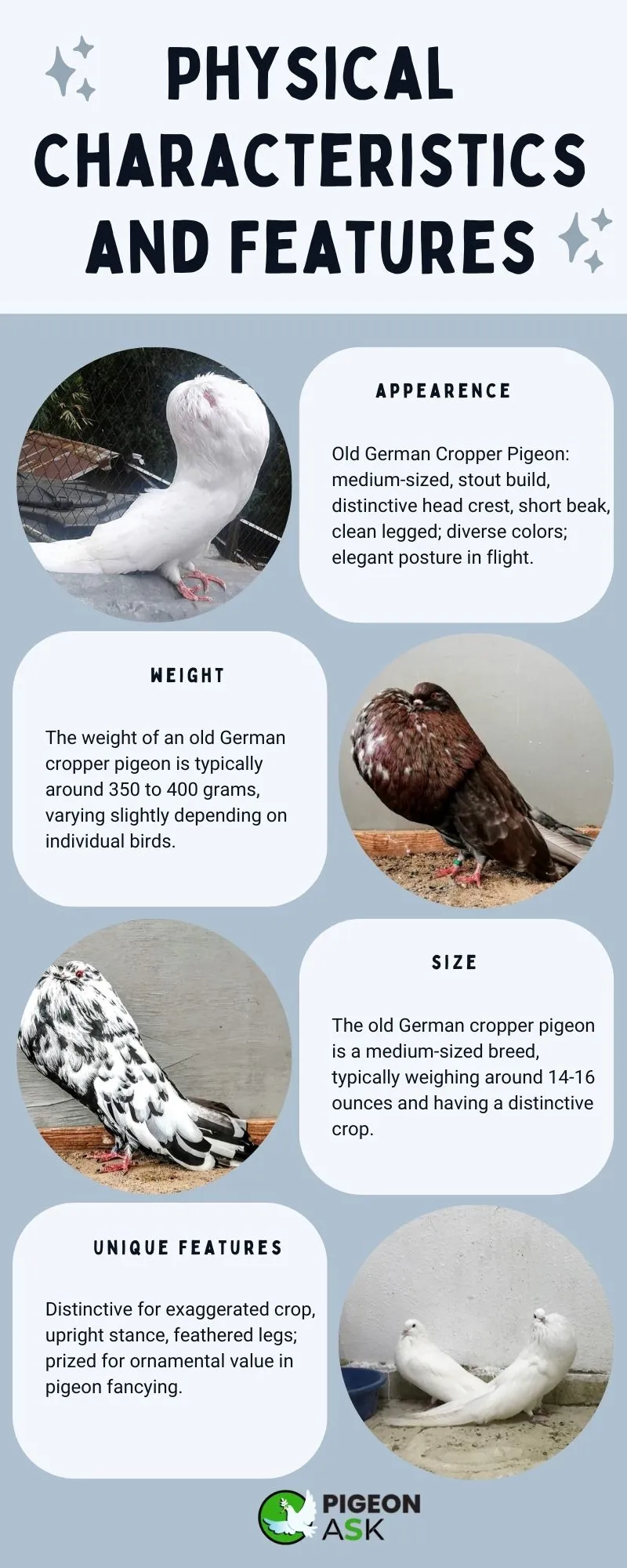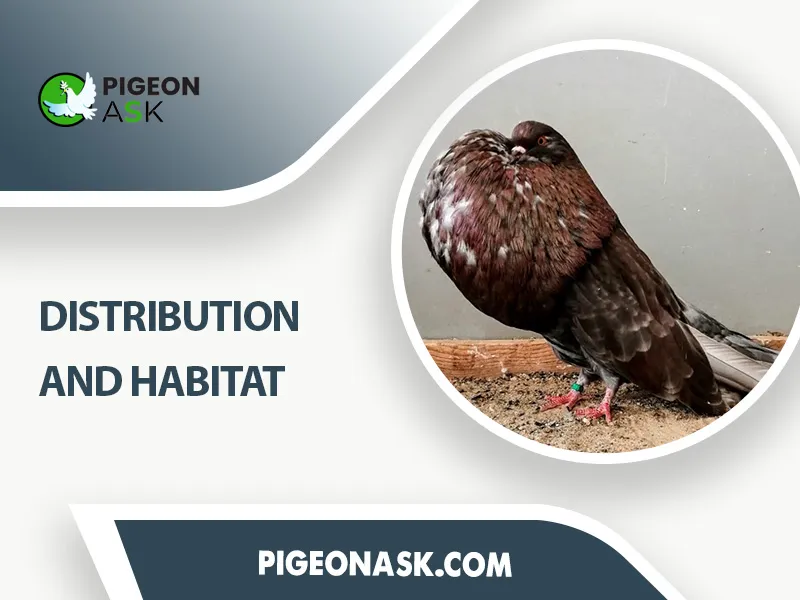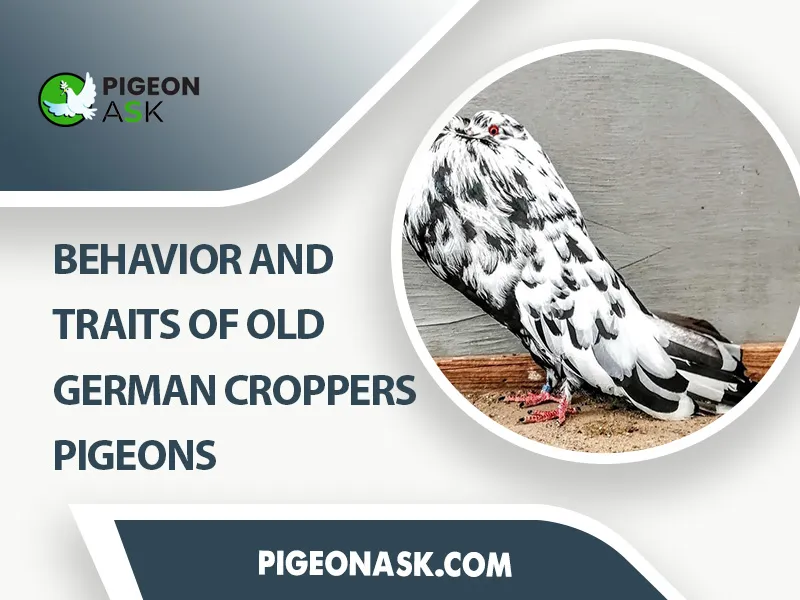Old German Cropper Pigeon: Our Breed Guide
The Old German Cropper pigeon, renowned for its large size and well-inflated oval-to-round globe, is a breed that originated in Germany and Hungary through years of selective breeding.
Descended from the rock pigeon (Columba livia), it holds the distinction of being one of the longest among pigeon breeds.
However, these birds aren’t all about beauty and if you are planning to breed them, then you need to learn all the necessary details about Old German Cropper Pigeons.
Don’t fret because, in this guide, I will discuss all the necessary details you need to be aware of when it comes to Old German Cropper pigeons. You will learn about their characteristics and food habits along with a detailed care guide.
Old German Cropper Pigeon Profile
Here’s a concise profile of the Old German Cropper Pigeon –
| Feature | Description |
|---|---|
| Scientific Name | Columba livia |
| Common Names | Old German Cropper, German Cropper, German Bagdad, German Beauty Homer |
| US Breed Group | Fancy |
| EE Breed Group | Cropper Pigeons |
| Origin | Germany and Hungary |
| Body Shape | Large with a well-inflated globe |
| Posture | Stands with the front of its body raised |
| Wing Length | Very long, extending beyond the tail |
| Colors | Black, white, dun, cream, red, yellow, silver, mealy, blue in bar and check, lark |
Old German Cropper: Overview
Primarily raised for exhibition purposes, the Old German Cropper, despite its substantial size, maintains a non-heavy body.
Standing in a semi-erect station with the front of its body raised, the Old German Cropper features very long wings that extend ideally beyond the tail.

These wings should exhibit a smooth line without a “sail-like effect” caused by raised secondary feathers.
Available in various colors such as black, white, dun, cream, red, yellow, silver, mealy, blue in bar and check, and lark, these self-colored birds may also display a splash or a random mixture of white and colored feathers.
History and Origins of Old German Cropper Pigeons
The Old German Cropper, known as Altdeutscher Kröpfer in its native area, is an ancient pigeon breed originating from Germany and Hungary.
Developed over many years through selective breeding, some enthusiasts consider it as old as the Old Holland Pouter. There are indications of a common ancestry with the Hungarian Giant Cropper, suggesting a similarity between the two breeds.
Initially bred in a large area, the Old German Cropper served various purposes. It functioned primarily as a flying pigeon and was also kept as a utility breed and fancy pigeon.
Its popularity grew in Germany, especially at shows in Holland after its introduction by Van Gink.
Today, the breed is mainly raised for exhibition purposes and has expanded beyond its native region to other countries. Despite its substantial size, the Old German Cropper maintains a non-heavy body.
Feather development is expected to be smooth and neat without being tight. Notably, the breed is recognized for its long wings, adding to its distinctive appearance.
The Old German Cropper Pigeon has a rich history, originating in Germany and Hungary.
Developed through selective breeding, it served as a flying pigeon, utility breed, and fancy pigeon in its early years. Presently, its primary role is in exhibition purposes.
Physical Characteristics and Features
| Name | Characteristics |
|---|---|
| Size | Large |
| Weight | 700 to 750 grams |
| Lifespan | Up to 10 years |
| Physical Features | Long and robust body with broad shoulders and large wingspans |
| Temperament | Calm and docile |
| Behavior | Social and Friendly |
| Special Features | Inflated Globe, Fan-shaped tail |
| Breeding and Maintenance | Easy to raise and breed |

Appearance
The Old German Cropper Pigeon is a large and powerful breed, recognized for its distinctive features. Holding the title of the longest pigeon breed, it boasts a wingspread of three feet or more.
Despite its substantial size, the bird maintains a non-heavy body, presenting the overall appearance of a robust pigeon.
Size and Body Structure
Standing in a semi-erect station with the front of its body raised, the Old German Cropper features a large, well-inflated globe that is oval to round in shape. The bird’s wings are notably long, extending ideally beyond the tail.
With fairly short legs that do not reveal the thighs, mature birds average a live body weight of about 700 to 750 grams.
Unique Features
A distinguishing feature of the Old German Cropper is its long wings, contributing significantly to its distinct appearance.
The wings should be well closed, avoiding a “sail-like effect” caused by raised secondary feathers that disrupt the smooth wing line.
And the crop of this breed is well developed, but due to the body’s form, it takes on an inverted and pearlike shape, sloping gradually to the body rather than being globular.
Feather Color and Variations
Available in various colors such as black, white, dun, cream, red, yellow, silver, mealy, blue in bar and check, and lark, the Old German Cropper exhibits self-colored patterns.
Additionally, variations include splash or a random mixture of white and colored feathers. For example –
- Tiger with dark flights and tail alongside white feathers sprinkled on the body.
- Flights marked with a solid-colored body and evenly marked white flights on both wings.
- Mussel heads are primarily found in black with a sprinkling of white.
Distribution And Habitat
These pigeons have established a global presence, settling in diverse urban and rural locales, ranging from the rooftops of city buildings to the expansive aviaries of rural estates.
Their adaptability, coupled with the commitment of pigeon enthusiasts, has enabled them to flourish in various environments, even in the most extreme latitudes.

Unlike their wild counterparts, these domesticated pigeons forego seasonal migrations, choosing instead to remain within their human-made enclosures year-round.
While the Old German Cropper Pigeons are not classified as threatened or endangered, their survival and well-being are intricately linked to human care.
In next sections, we will delve deeper into the geographic distribution, habitat preferences, urban and rural habitats, migration and seasonal movements, and conservation status of these remarkable birds.
Geographic Distribution
Old German Cropper Pigeons, like other domesticated pigeons, are widespread globally, particularly in areas with pigeon enthusiasts and breeders.
Originating in Germany and Hungary, their unique features and robust health have enabled them to thrive in diverse regions worldwide.
While primarily a European pigeon breed, they are also cherished in countries like the USA, Russia, and beyond.
Habitat Preferences
Domesticated Old German Cropper Pigeons are commonly housed in human-built enclosures such as well-maintained aviaries or lofts.
They flourish in captivity, provided there is access to clean water, quality food sources, and suitable nesting arrangements.
Urban and Rural Habitats
These pigeons demonstrate adaptability to both urban and rural environments. In urban areas, they often inhabit backyard lofts or rooftops, while in rural settings, larger aviaries on private properties are common.
Their ability to thrive near humans is evident worldwide, from towns north of the Arctic Circle to as far south as Ushuaia, Argentina.
Migration and Seasonal Movements
In contrast to many wild bird species, Old German Cropper Pigeons do not partake in long-distance migratory or seasonal movements. Bred and raised in captivity, they remain confined to their aviaries throughout the year.
Threats and Conservation Status
As a common and domesticated breed, Old German Cropper Pigeons are not classified as endangered or threatened. Nevertheless, like any domesticated animal, their survival and well-being depend on proper care from humans.
Behavior And Traits of Old German Croppers Pigeons
Old German Cropper Pigeons are known for their vibrant colors and friendly demeanor. These non-migratory birds prefer staying close to their human caretakers year-round.

Despite their substantial build, they exhibit gentle behavior, only turning aggressive when necessary.
Expressive Behavior
They display unique behaviors like gaping or pouting, linked to mate attraction, dominance assertion, and predator deterrence. These pigeons aren’t long-distance flyers and choose to remain with their human companions.
Temperament Highlights
They are known for their gentle nature but can show aggression if needed. Male pigeons court mates with head nods and feather displays, resulting in a sweet mating process.
While individual behavior may vary, understanding these traits provides insights into the unique charm of Old German Cropper Pigeons.
Courtship
Old German Cropper pigeons are monogamous, forming a lifelong pair bond. During courtship, the male showcases unique physical traits.
Puffing up its crop, a characteristic behavior of pouter or cropper breeds, the male attracts the female.
This display not only emphasizes size but also highlights the male’s ability to control crop inflation and deflation, indicating good health and strength.
Nesting
Once paired, Old German Cropper pigeons collaborate to build a nest, typically in a box using materials like feathers and straws.
A spacious loft and a comfortable nest box are crucial for encouraging breeding, providing the pair with ample space to display unique courtship behaviors such as inflating globes and strutting around.
Breeding
As a seasoned breeder of Old German Cropper pigeons, this comprehensive guide is tailored for enthusiasts already familiar with pigeon breeding basics, offering an in-depth look into the specifics of breeding these magnificent birds.
01. Pair Formation and Courtship
Old German Croppers, displaying a lifelong monogamous pair bond, engage in courtship by the male puffing up its crop to attract a female.
02. Nest Building
Following pair formation, collaborative nest-building commences in a box, utilizing materials like feathers and straws. A spacious loft and a comfortable nest box are pivotal for encouraging successful breeding.
03. Diet and Health
The breeding process hinges on a balanced diet, ensuring optimal egg health and the birth of robust offspring. Regular health checks are essential to maintain the pigeons’ disease and parasite-free status.
04. Egg Laying and Incubation
Typically, the female lays one or two eggs, incubated by both parents for a slightly over two-week period.
05. Fledging
After hatching, the fledging period spans approximately 30 days, during which young pigeons grow the feathers necessary for flight.
06. Training and Socialization
Young pigeons undergo training and socialization, which may involve hand feeding to foster trust and familiarity with humans.
07. Selection for Breeding
As pigeons mature, usually around six months, selective breeding is based on factors such as health, size, color, and other desirable traits.
08. Exhibition and Shows
Old German Cropper pigeons, often bred for exhibition, see show-quality birds selected according to the National Pigeon Association (NPA) standard for each breed.
Bear in mind that while specific details about the Old German Cropper’s breeding program are somewhat limited, they likely adhere to observed patterns in other cropper breeds and domestic pigeons.
This guide, specifically designed for Old German Croppers, is equally relevant to a broader spectrum of pigeon breeds.
Some TIPS and Considerations for Successful Breeding
For successful breeding of Old German Cropper pigeons, here are some additional tips and considerations that are essential but not previously mentioned –
- Loft Environment: Keep the loft dry and sheltered from rain or snow to prevent diseases and parasites.
- Separation of Birds: Have separate houses for mated pairs and odd birds to avoid conflicts and maintain a peaceful breeding environment.
- Flypen Requirements: If your breed requires a flypen, ensure it dries out easily for hygiene and disease prevention.
- Regular Health Checks: Regular health checks are crucial to prevent diseases, parasites, or vermin issues before they occur.
- Proper Housing and Feeding: Success in raising pigeons depends on proper housing and feeding. Provide a good loft, clean feed, quality grit, and always clean water.
- Use of Surrogate Pigeons: Some Pouters benefit from having standby surrogate pigeons to ensure the successful rearing of the young.
- Selective Breeding: Be selective in breeding, aiming for birds that meet the standard ideal. This requires patience and persistence.
- Control of Gene Pool: Exercise caution in allowing only birds that meet the standard ideal to breed, avoiding those with incorrect markings or undesirable traits.
- Beak Care: Breeds with short beaks or different shapes require ‘Beak Care,’ including gentle filing to maintain the required shape.
- Foster Parents: Certain breeds may need foster parents to rear the young, requiring knowledge in synchronizing matings and pairings.
- Exhibition Preparation: If you exhibit your birds, perform necessary ‘trimming’ or pre-show preparation.
- Patience with Novice Breeders: Novice breeders often lack patience. It’s crucial to persevere and celebrate successes when a bird meets the standard ideal.
- Avoiding Inbreeding: Ensure genetic diversity to avoid health issues and reduced vitality in offspring by avoiding inbreeding.
- Socialization: Proper socialization from a young age leads to tamer and more manageable pigeons.
- Bathing Opportunities: Provide large and deep water bowls for bathing, as pigeons enjoy and benefit from regular baths.
By following these tips, breeders can enhance the success of their Old German Cropper pigeon breeding program.
Final Thoughts
The Old German Cropper pigeon is a remarkable breed but can be difficult to breed if you are not careful due to their large size and high demands. Understanding their nature and requirements is the key to success here.
But if you are able to follow this guide and take the necessary steps, then you should be able to breed them perfectly. Best of luck!
